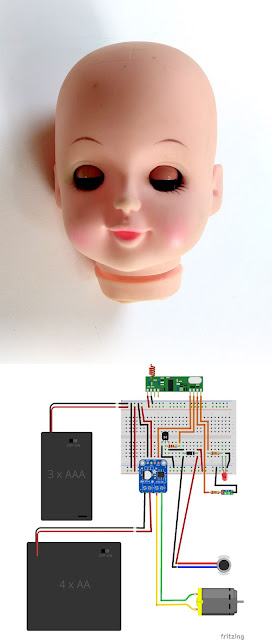These old motors are super sturdy, reasonably powerful and the gearing makes them great for any hobby level robotics project. And of course, they fit into the entire LEGO ecosystem so they are easy to prototype with.
 |
| Just a few leftover LEGO Mindstorms Technic motors. And I've got lots more Mindstorms and Technic parts, plus quite a few Bionicle sets. |
So the motors and other items languished in storage for years. But I wanted to find one of my robot chassis (still assembled after all these years) to use with some beginning roboticists. I was going to 3d print some adaptors for the cheap DC motors. But when I saw the old motors I realized I could just cut the LEGO connector wires and plug them directly into a motor driver.
Normally, I would just upgrade to newer equipment, but I have a dozen of these motors and several robot chassis and mechanical contraptions that are already designed ( and more importantly, already assembled) to work with this style of motor. Since the motors are designed to run on 9v (I remember running them at up to 12v without damage) so I knew they would work well with several of the Arduino motor drivers I already have. I decided to put these handy little motors back to work.
I chose to use Adafruit's Motor Shield. It can handle 9-12v easily and has handy screw terminals for attaching wires. And the well-written library makes it easy for new roboteers to program their creations. It gives you four DC motor outputs (or two stepper motors) as well as two servo ports. And it leaves the analog and digital inputs to use with sensors.
Put the shield on top of a UNO and they are about the same size as the old RCX, so they fit perfectly onto the existing robot chassis. Or use one of the new M4 powered UNO compatibles and have enough power and speed to run a full color touch screen display, Bluetooth, GPS and a 10 DOF sensor board. You could even get one of the smaller boards like a Feather or Teensy.
Hooking up the motors is simple. Just use one of the Mindstorms motor cable and cut the wire that runs between the two LEGO connectors. You will get two cables, one end with a LEFO connector and one with just wire. Strip a small amount of insulation off the wire. Attach the connector to the motor, then screw down the wires into any of the four ports on the motor shield. Use the LEGO motors like any other DC motor.
 |
| Just snip the wire between the connector blocks and attach them to the screw-terminals of the motor shield. |
You could get fancy and tin the wire with solder, crimp a pin to the wire, or splice it into a breadboard style wire.
Now build a robot and code the Arduino using the library for the motor shield.
- An entire book on LEGO and Arduiono (affiliate link)
- And another book on combining LEGO and Arduinos (affiliate link)
- Geggos custom PCBs with ESP, BLE, WiFi and Steam capabilities
- Dexter Industries has a wide variety of LEGO plus Arduino or RasPi projects
- You can also get Dexter project kits on Amazon (affiliate link)
- Make your own connectors with this Instructable
- Of course the Arduino website has a collection of projects
- GenerationRobots has some RasPi kits
- Mindsensors has been making add-ons and kits for years
- An Instructable on controlling LEGO servo motors
As an Amazon Associate I earn from qualifying purchases.
Shop through our Amazon links to help support this site.
Shop through our Amazon links to help support this site.
Also find me on:



